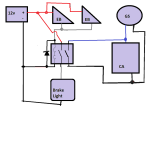Thanks for your prompt reply AmberWolf.
After doing a bit of reading to learn how to use a relay as an XOR gate, I read and re-read your 2nd paragraph then drew what I think you meant up so I could walk through the circuit and understand how it would work:
In these diagrams, the blue boxes are just visual shorthand for the opto-isolated circuits described earlier in this thread, where a GND signal from the brake levers triggers a 12v supply on the output.
I can see how 12v on the left side of the relay coil and GND on the right, triggered by the brake lever switches, would charge the relay coil and close the contacts, allow the GND from the brake levers to pass to the CA which cuts the motor and also supplies power to the brake light. However, if there's 12v on the right, triggered by the gear change sensor, either relay coil gets charge (albeit in reverse polarity) closes the contacts and then powers the light, or if both left and right sides of the coil are powered, the coil has no voltage drop across it, doesn't close the contacts, and while the CA still cuts motor because of the direct connection from the gear change sensor, the brake light doesn't come on despite the brake levers switches being closed.
I'm quite sure this is not what you meant AMberwolf... but with my limited knowledge (electronics was a looooong time ago for me) I'm struggling to understand. Sigh.
However, you did give me plenty to think about, and I like your idea of using the relay to separate 12v from the 5v CA and 52v traction components.... so I came up with an alternative design that looks like it might work?
I put a diode in front of the brake side of the relay to isolate any charge from the right side, and took a feed prior from the opto-isolated 12v GND triggered output straight to the brake light. Not needing a DPST relay, its now a SPST 12v relay. Now charging either side of the coil (but not both) will close the contacts and cut the motor at the CA. Only the left side can power the light, because of the diode, and if both sides of the coil are charged, the brake light still comes on, the relay doesn't trip, and the motor cuts out due to the direct connection from the gear change sensor.
Does anyone want to challenge this schematic and tell me it won't work?






